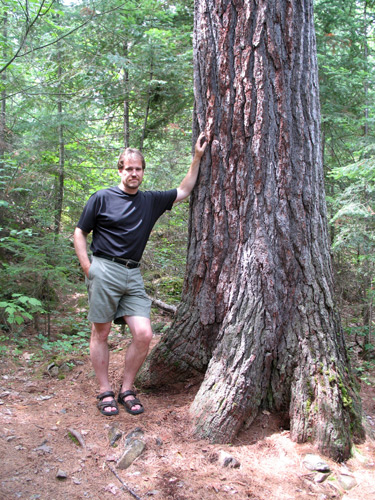
This is one project that Paul Sibley likely won’t see to its end. To do that, the environmental sciences professor would have to live for another five centuries. But he’s glad to help seed a planned old-growth forest in Guelph with a public talk given this month about his research linking healthy forests and clean water.
“Where the Forest Touches the Water: A Meeting Place for Human Values” was the topic of Sibley’s talk at Guelph’s Ignatius Jesuit Centre (IJC). It was part of a speaker series held this spring by the Plant an Old-Growth Forest Project and the U of G Arboretum.
The Jesuit centre is nurturing an old-growth forest in north Guelph on a parcel of land between Hwy. 6 and Victoria Road.
“We’re calling it the 500-year project,” says project co-ordinator Leslie Work, who studied entomology at Guelph in the late 1980s.
The centre will apply for a conservation easement to protect a 40-hectare area of mixed forest and wetland for perpetuity. All going well, says Work, the site will be left untouched for centuries and allow an old-growth forest to develop.
There’s more to an old-growth forest than ancient trees, although such a stand typically contains specimens that are hundreds of years old. Also called a climax or steady-state forest, an old-growth forest contains trees of every age, but their average age barely changes, according to the book Ontario’s Old-Growth Forests, published this year by Ontario ecologists Michael Henry and Peter Quinby.
These sites have matured over centuries. Typically they contain a multi-layered canopy with plenty of big shade-tolerant trees ─ white pine, white cedar, black spruce, sugar maple, American beech ─ instead of pioneer sun-lovers like birch or aspen. There are usually many dead standing trees and rotting logs, and the forest floor often undulates in pits and mounds where giant trees have been uprooted and left to decay.
For examples, you need look no further than the University’s Arboretum.
Parts of Victoria Woods, Wild Goose Woods and the nature reserve contain old-growth areas untouched “since the glaciers,” says Chris Earley, interpretive biologist and education co-ordinator. Besides the usual pit-and-mound topography, these areas contain signature old-growth tree species, notably sugar maple and beech, with several specimens up to 300 years old.
“It’s pretty cool because most people don’t think that right in the middle of Guelph we have an old-growth forest,” says Earley.
Across Guelph, the IJC site occupies a dogleg of land bounded to the north by a housing tract and to the south by the Speed River. Its existing hardwood forest contains ash, basswood, maple, beech and butternut, among other species. The site also contains a cedar forest and former farm fields.
This year, the centre will remove an 80-year-old dam to drain a former millpond spanning Hwy. 6. Taking out the dam is the final step in a decade-long project that has already restored upstream portions of Marden Creek.
Organizers plan to seed and plant the flats along the restored creek to create a wetland. The forest restoration will involve seeding and planting as well as removing invasive species and allowing natural forest succession to occur.
“We realize that we can’t plant an old-growth forest, but we can create the conditions for one,” explains Work. “Time is the most important factor. We’re planting seeds in our own consciousness of allowing the land to heal. We’re planting the seeds of something big.”
Sibley says nurturing a healthy forest helps clean water by reducing soil erosion and by filtering nutrients and contaminants. Riparian areas along rivers and streams account for less than two per cent of the landscape, but they’re important for water quality and biodiversity.
“These interfaces are not just places where trees meet the water. They serve all kinds of functions,” says Sibley. His research in northern Ontario is intended to help forestry companies incorporate different values ─ ecological, recreational, cultural, economic ─ when harvesting trees in riparian areas.
He says the IJC old-growth forest project might provide project topics for U of G undergrads in several courses.